An official website of the United States government
 United States Department of Labor
United States Department of Labor
Operate or tend hoists or winches to lift and pull loads using power-operated cable equipment. Excludes "Crane and Tower Operators" (53-7021).
Employment estimate and mean wage estimates for Hoist and Winch Operators:
| Employment (1) | Employment RSE (3) |
Mean hourly wage |
Mean annual wage (2) |
Wage RSE (3) |
|---|---|---|---|---|
| 4,460 | 7.2 % | $ 30.16 | $ 62,730 | 3.0 % |
Percentile wage estimates for Hoist and Winch Operators:
| Percentile | 10% | 25% | 50% (Median) |
75% | 90% |
|---|---|---|---|---|---|
| Hourly Wage | $ 15.05 | $ 20.26 | $ 30.10 | $ 39.36 | $ 47.39 |
| Annual Wage (2) | $ 31,310 | $ 42,140 | $ 62,610 | $ 81,860 | $ 98,560 |
Industries with the highest published employment and wages for Hoist and Winch Operators are provided. For a list of all industries with employment in Hoist and Winch Operators, see the Create Customized Tables function.
Industries with the highest levels of employment in Hoist and Winch Operators:
| Industry | Employment (1) | Percent of industry employment | Hourly mean wage | Annual mean wage (2) |
|---|---|---|---|---|
| Support Activities for Water Transportation | 1,780 | 2.02 | $ 33.83 | $ 70,370 |
| Local Government, excluding schools and hospitals (OEWS Designation) | 200 | 0.00 | (8) | (8) |
| Printing and Related Support Activities | 160 | 0.04 | (8) | (8) |
| Support Activities for Mining | 140 | 0.05 | $ 25.29 | $ 52,610 |
| Electric Power Generation, Transmission and Distribution | 110 | 0.03 | $ 43.75 | $ 91,010 |
Industries with the highest concentration of employment in Hoist and Winch Operators:
| Industry | Employment (1) | Percent of industry employment | Hourly mean wage | Annual mean wage (2) |
|---|---|---|---|---|
| Support Activities for Water Transportation | 1,780 | 2.02 | $ 33.83 | $ 70,370 |
| Coal Mining | 110 | 0.25 | $ 28.23 | $ 58,710 |
| Logging | 80 | 0.16 | $ 24.83 | $ 51,640 |
| Alumina and Aluminum Production and Processing | 80 | 0.14 | $ 15.83 | $ 32,920 |
| Sawmills and Wood Preservation | 90 | 0.10 | $ 15.74 | $ 32,750 |
Top paying industries for Hoist and Winch Operators:
| Industry | Employment (1) | Percent of industry employment | Hourly mean wage | Annual mean wage (2) |
|---|---|---|---|---|
| Electric Power Generation, Transmission and Distribution | 110 | 0.03 | $ 43.75 | $ 91,010 |
| Nonresidential Building Construction | 40 | (7) | $ 41.04 | $ 85,360 |
| Building Equipment Contractors | (8) | (8) | $ 36.85 | $ 76,640 |
| Death Care Services | (8) | (8) | $ 35.42 | $ 73,660 |
| Nonmetallic Mineral Mining and Quarrying | (8) | (8) | $ 34.15 | $ 71,030 |
States and areas with the highest published employment, location quotients, and wages for Hoist and Winch Operators are provided. For a list of all areas with employment in Hoist and Winch Operators, see the Create Customized Tables function.
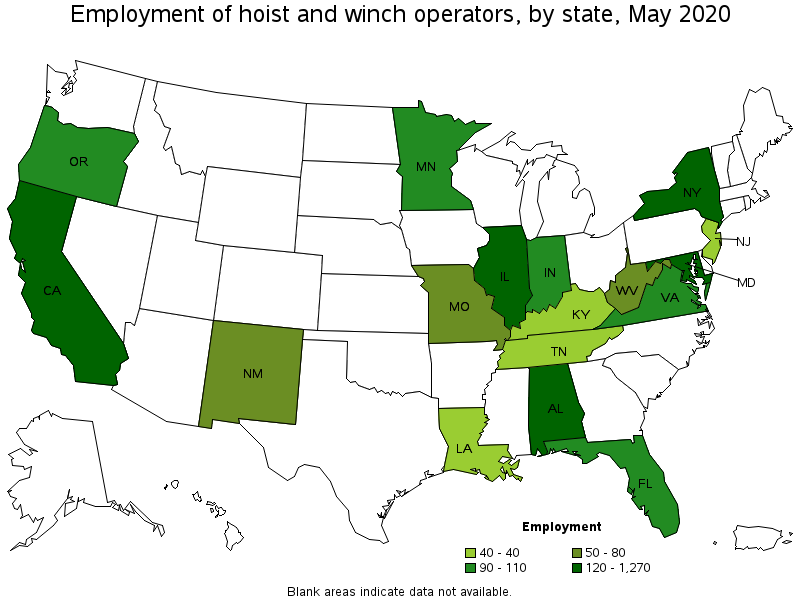
States with the highest employment level in Hoist and Winch Operators:
| State | Employment (1) | Employment per thousand jobs | Location quotient (9) | Hourly mean wage | Annual mean wage (2) |
|---|---|---|---|---|---|
| California | 1,270 | 0.08 | 2.41 | $ 34.53 | $ 71,820 |
| Illinois | 260 | 0.05 | 1.46 | (8) | (8) |
| Maryland | 150 | 0.06 | 1.88 | $ 27.68 | $ 57,580 |
| New York | 140 | 0.02 | 0.52 | $ 28.93 | $ 60,180 |
| Alabama | 120 | 0.06 | 1.90 | $ 20.50 | $ 42,630 |
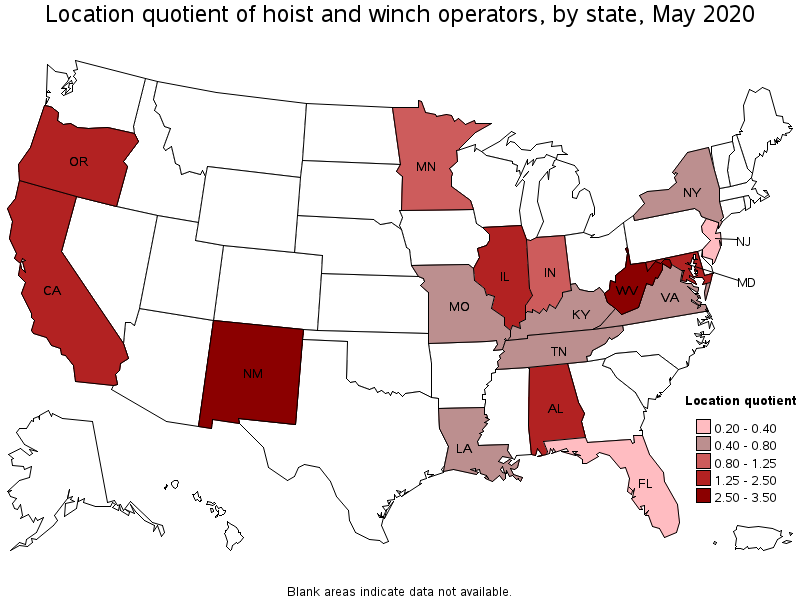
States with the highest concentration of jobs and location quotients in Hoist and Winch Operators:
| State | Employment (1) | Employment per thousand jobs | Location quotient (9) | Hourly mean wage | Annual mean wage (2) |
|---|---|---|---|---|---|
| New Mexico | 80 | 0.10 | 3.01 | $ 31.88 | $ 66,310 |
| West Virginia | 60 | 0.09 | 2.87 | $ 28.46 | $ 59,190 |
| California | 1,270 | 0.08 | 2.41 | $ 34.53 | $ 71,820 |
| Alabama | 120 | 0.06 | 1.90 | $ 20.50 | $ 42,630 |
| Maryland | 150 | 0.06 | 1.88 | $ 27.68 | $ 57,580 |
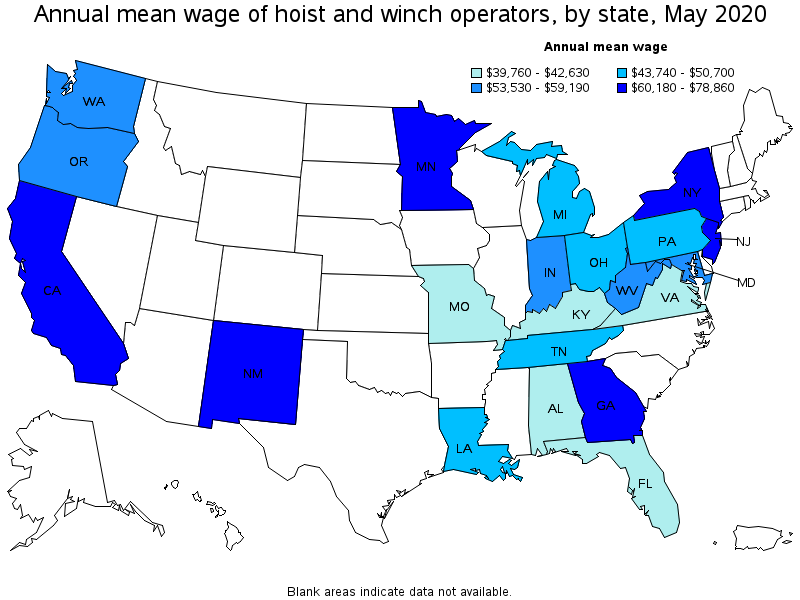
Top paying states for Hoist and Winch Operators:
| State | Employment (1) | Employment per thousand jobs | Location quotient (9) | Hourly mean wage | Annual mean wage (2) |
|---|---|---|---|---|---|
| Minnesota | 100 | 0.04 | 1.12 | $ 37.91 | $ 78,860 |
| New Jersey | 40 | 0.01 | 0.36 | $ 36.85 | $ 76,640 |
| California | 1,270 | 0.08 | 2.41 | $ 34.53 | $ 71,820 |
| Georgia | (8) | (8) | (8) | $ 32.32 | $ 67,220 |
| New Mexico | 80 | 0.10 | 3.01 | $ 31.88 | $ 66,310 |
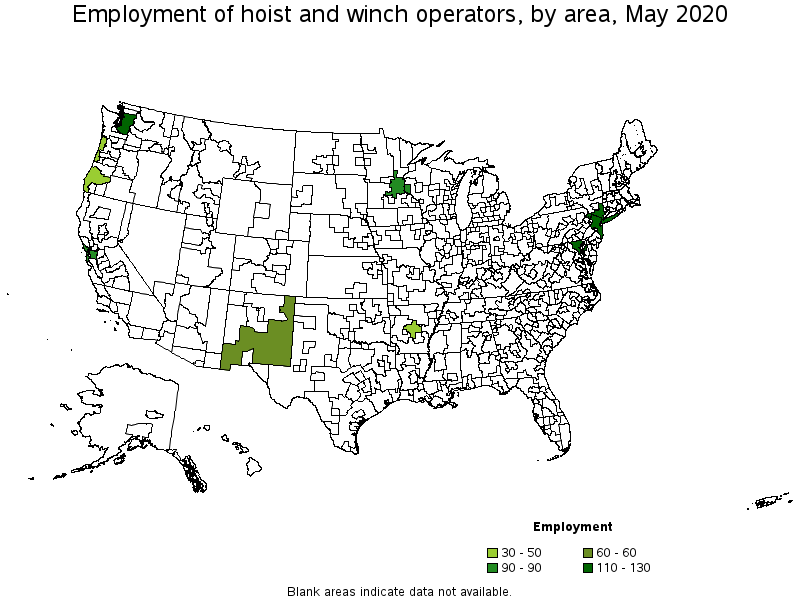
Metropolitan areas with the highest employment level in Hoist and Winch Operators:
| Metropolitan area | Employment (1) | Employment per thousand jobs | Location quotient (9) | Hourly mean wage | Annual mean wage (2) |
|---|---|---|---|---|---|
| Baltimore-Columbia-Towson, MD | 130 | 0.10 | 3.18 | $ 29.11 | $ 60,550 |
| New York-Newark-Jersey City, NY-NJ-PA | 110 | 0.01 | 0.39 | $ 36.58 | $ 76,080 |
| Seattle-Tacoma-Bellevue, WA | 110 | 0.06 | 1.74 | $ 31.45 | $ 65,420 |
| Minneapolis-St. Paul-Bloomington, MN-WI | 90 | 0.05 | 1.58 | $ 38.37 | $ 79,810 |
| San Francisco-Oakland-Hayward, CA | 90 | 0.04 | 1.24 | $ 38.68 | $ 80,450 |
| Little Rock-North Little Rock-Conway, AR | 30 | 0.09 | 2.94 | $ 19.05 | $ 39,630 |
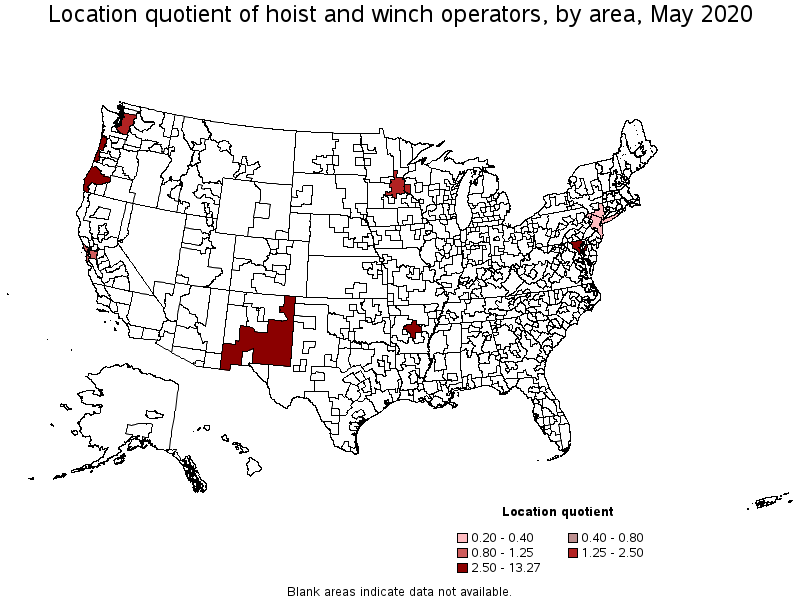
Metropolitan areas with the highest concentration of jobs and location quotients in Hoist and Winch Operators:
| Metropolitan area | Employment (1) | Employment per thousand jobs | Location quotient (9) | Hourly mean wage | Annual mean wage (2) |
|---|---|---|---|---|---|
| Baltimore-Columbia-Towson, MD | 130 | 0.10 | 3.18 | $ 29.11 | $ 60,550 |
| Little Rock-North Little Rock-Conway, AR | 30 | 0.09 | 2.94 | $ 19.05 | $ 39,630 |
| Seattle-Tacoma-Bellevue, WA | 110 | 0.06 | 1.74 | $ 31.45 | $ 65,420 |
| Minneapolis-St. Paul-Bloomington, MN-WI | 90 | 0.05 | 1.58 | $ 38.37 | $ 79,810 |
| San Francisco-Oakland-Hayward, CA | 90 | 0.04 | 1.24 | $ 38.68 | $ 80,450 |
| New York-Newark-Jersey City, NY-NJ-PA | 110 | 0.01 | 0.39 | $ 36.58 | $ 76,080 |
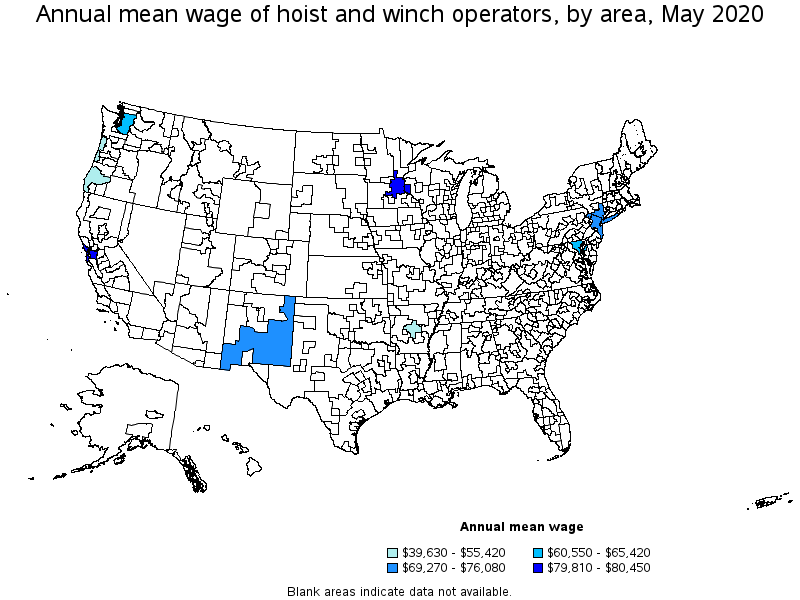
Top paying metropolitan areas for Hoist and Winch Operators:
| Metropolitan area | Employment (1) | Employment per thousand jobs | Location quotient (9) | Hourly mean wage | Annual mean wage (2) |
|---|---|---|---|---|---|
| San Francisco-Oakland-Hayward, CA | 90 | 0.04 | 1.24 | $ 38.68 | $ 80,450 |
| Minneapolis-St. Paul-Bloomington, MN-WI | 90 | 0.05 | 1.58 | $ 38.37 | $ 79,810 |
| New York-Newark-Jersey City, NY-NJ-PA | 110 | 0.01 | 0.39 | $ 36.58 | $ 76,080 |
| Seattle-Tacoma-Bellevue, WA | 110 | 0.06 | 1.74 | $ 31.45 | $ 65,420 |
| Baltimore-Columbia-Towson, MD | 130 | 0.10 | 3.18 | $ 29.11 | $ 60,550 |
| Little Rock-North Little Rock-Conway, AR | 30 | 0.09 | 2.94 | $ 19.05 | $ 39,630 |
Nonmetropolitan areas with the highest employment in Hoist and Winch Operators:
| Nonmetropolitan area | Employment (1) | Employment per thousand jobs | Location quotient (9) | Hourly mean wage | Annual mean wage (2) |
|---|---|---|---|---|---|
| Eastern New Mexico nonmetropolitan area | 60 | 0.41 | 12.79 | $ 33.31 | $ 69,270 |
| Coast Oregon nonmetropolitan area | 50 | 0.43 | 13.27 | $ 26.65 | $ 55,420 |
Nonmetropolitan areas with the highest concentration of jobs and location quotients in Hoist and Winch Operators:
| Nonmetropolitan area | Employment (1) | Employment per thousand jobs | Location quotient (9) | Hourly mean wage | Annual mean wage (2) |
|---|---|---|---|---|---|
| Coast Oregon nonmetropolitan area | 50 | 0.43 | 13.27 | $ 26.65 | $ 55,420 |
| Eastern New Mexico nonmetropolitan area | 60 | 0.41 | 12.79 | $ 33.31 | $ 69,270 |
Top paying nonmetropolitan areas for Hoist and Winch Operators:
| Nonmetropolitan area | Employment (1) | Employment per thousand jobs | Location quotient (9) | Hourly mean wage | Annual mean wage (2) |
|---|---|---|---|---|---|
| Eastern New Mexico nonmetropolitan area | 60 | 0.41 | 12.79 | $ 33.31 | $ 69,270 |
| Coast Oregon nonmetropolitan area | 50 | 0.43 | 13.27 | $ 26.65 | $ 55,420 |
These estimates are calculated with data collected from employers in all industry sectors, all metropolitan and nonmetropolitan areas, and all states and the District of Columbia. The top employment and wage figures are provided above. The complete list is available in the downloadable XLS files.
The percentile wage estimate is the value of a wage below which a certain percent of workers fall. The median wage is the 50th percentile wage estimate—50 percent of workers earn less than the median and 50 percent of workers earn more than the median. More about percentile wages.
(1) Estimates for detailed occupations do not sum to the totals because the totals include occupations not shown separately. Estimates do not include self-employed workers.
(2) Annual wages have been calculated by multiplying the hourly mean wage by a "year-round, full-time" hours figure of 2,080 hours; for those occupations where there is not an hourly wage published, the annual wage has been directly calculated from the reported survey data.
(3) The relative standard error (RSE) is a measure of the reliability of a survey statistic. The smaller the relative standard error, the more precise the estimate.
(7) The value is less than .005 percent of industry employment.
(8) Estimate not released.
(9) The location quotient is the ratio of the area concentration of occupational employment to the national average concentration. A location quotient greater than one indicates the occupation has a higher share of employment than average, and a location quotient less than one indicates the occupation is less prevalent in the area than average.
Other OEWS estimates and related information:
May 2020 National Occupational Employment and Wage Estimates
May 2020 State Occupational Employment and Wage Estimates
May 2020 Metropolitan and Nonmetropolitan Area Occupational Employment and Wage Estimates
May 2020 National Industry-Specific Occupational Employment and Wage Estimates
Last Modified Date: March 31, 2021